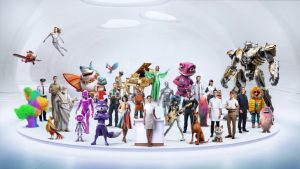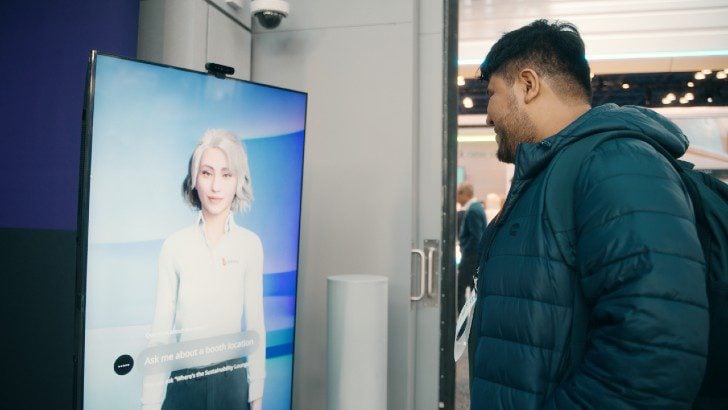
“At bitHuman, we do these lifelike interactive AI agents targeting primarily business customers. Through the live AI agents, we’re creating this very engaging and fun experience that we imagine can be very useful for retail, hospitality, fashion and beyond.”

What is your vision for bitHuman?
“The whole world is moving towards interactive AI. We want to be the one leading the trend and bringing this interactive and engaging experience to our customers. Today, it’s still a very novel experience that very few people have ever experienced talking to AI in a very interactive and fun engaging way. Still, I think it’s coming, and we wish bitHuman to be the leading player in this space.”
bithuman talks about having a visual rendering of a human. What do you mean by a visual render?
“It’s much more than a photo; it’s generative. We’re basically creating a generative pipeline that can generate all sorts of different characters. They’re not just humans. They can be cartoons. They can be a movie character.
Dealing with the uncanny valley
Where bitHuman differs from a recording is that it generates the animation in real-time reacting to questions. Gu revealed that its animations include facial expressions, gestures and any other traits a human or different character might have. Realistic animation sometimes falls foul of the uncanny valley. What is your view of that?
“Uncanny valley can cover many different dimensions, both from the language, the likeness, the voice, the general personality, and we are tackling all those aspects. The good news is that after decades of research, we’re finally reaching a point now where through AI, we can overcome the uncanny valley. That’s very exciting for us. We think that today, it is doable. We can create these lifelike AI agents that are almost indistinguishable from a real person or real character.
“The other thing that I will say about uncanny valley is, it’s not just a person. We’re also talking about the different characters, different looks and feels, different likenesses. Some of them might be very friendly, very cute, very cartoonish, and other things, and this will help me overcome the uncanny valley as well.”
There are cultural differences across different countries. Some countries are more accepting of a human-like Avatar, and some countries are less accepting of them. It sounds like you have solved the problem by having less human-like avatars in those countries that have a serious problem with trusting androids.
In other countries, such as Japan and South Korea, you can use more human-like AI agents. Gu agreed with this viewpoint and explained the additional benefits that bitHuman provides. The bitHuman AI agent not only mimics a human, it also transcends the skill sets a normal human has, according to Gu. It is an aspect that Gu believes places it ahead of others.
On challenges
What are your key business challenges in the next 12 months?
“We want to deploy as many AI agents in the field in the next 12 months. We are currently in contact with several clients, some big and some small, to deploy our first batch of AI agents. We’re pretty excited about that. At NRF, we are also getting exposure to more clients and more customers as well. We are showcasing our technology in eight different locations at multiple entrances. They greet people, answer customer questions, and direct visitors to the booth. We’re very proud that we’re putting those agents in action.”
“If they want to have some fun, they should check out the bitHuman booth. At our booth, we’re going to showcase our latest technology with multiple different use cases in sales, in marketing, brand promotions, and solving customer issues. We also have a little souvenir and a gift for them as well. I will keep it as a surprise. We look forward to meeting them.”
On partnerships
What partnerships are you considering?
“We’re part of the NVIDIA Inception programme. We are part of the Microsoft ecosystem, working on startups. Beyond that, we’re looking for partnerships, from the hardware vendor side, for example, in order that our AI agent can live inside a big screen, a small screen, a hologram screen or a transparent screen.
“We’re also looking to partner with those operations folks as well. Because we want to help people understand how to use those AI agents in a lifelike setting, in a phygital concept – physical and digital.”
On the market
What does the competitive landscape look like?
“In terms of just video generation, there are quite a few AI companies that have been working on those things. There are a few companies that generate human-like videos. However, I want to emphasize that we focus exclusively on the real-time, generative human aspect. We are not a video generation platform. We are a generative AI character or figure platform.
“In that sense, we don’t see a lot of competition today. We do see some deployments in South Korea or maybe in Japan. They have put those agents in the airport. We haven’t seen as many deployments in the US or Europe yet. So that’s our primary focus in the market, and we want to be the one providing those service agents to our customers here.”
In which industries have you seen the greatest traction, as you appear to have quite a broad focus?
“We started with some deployments in the retail space. These are primarily convenience stores, big box retailers, and fashion shops. Now, we’re also looking into expansion with some apartment buildings and hospitals. I think retail is a very interesting place because we see clear pain points there.
“First of all, there’s a labour shortage; it’s very hard to hire people to be there all the time to provide customer service. When I go to Home Depot or Target, it’s always a pain in the ass to find any product in the shops. Now, imagine you have an agent there 24/7, always able to direct you to the right product and location answering questions and even running promotions as well. I think that’s going to be a very cool use case for us.”
Is that just customer service or something more?
“You could call that customer operations, but also marketing and sales as well. One of our agents that we deployed in Singapore is a greeting person, but they can also recommend products to the customers as well. Eventually, we will call that the Uber sales agent because they can combine multiple different skill sets into one, and they can also understand what the customers want through natural conversation dialogues.”
On Technology
What is the technology based on?
“We are developing our generative AI platform in-house that can do both voice likeness and movement, and we can generate them on the fly. We also work with OpenAI to leverage some of the language models. However, we are also running a customised version that allows us to deploy those models in our physical environment. So that customers can interact with the AI agents with very minimal delays and have a very good experience. Essentially, you can call that product a generative AI pipeline. It can emulate what a real person would do.”
When you’re creating customer service agents, you will need to use up data belonging to those customers. Where is that data held?
“That’s a great question. We’re very aware of GDPR and the CCPA. We respect customer privacy and where data is supposed to be stored locally. We also offer an agile solution that allows the agent to operate completely offline. On the cloud side, we partner with Microsoft, and we use the Azure service.”
You have three platform agents: Neo, One, and Eon. Where are they being used? Is there one that’s more successful than the others?
“Right now, our primary focus is on Neo, the service agent. As you browse the website, you’ll find that we’ve found use cases in retail and hospitality. Eventually, we think it’s different manifestations of the same platform that we’re building. One is basically a wellness agent that allows people to go through meditation and pursue inner peace.
“While EON allows our platform to use your likeness, your voice, your image, and your videos to create an agent that looks and behaves like you. For example, when we work with some big box retailers, they want to use one of their employees as the model to create an agent. We say, yeah, we can. Eon basically provides the means and tools for that to happen. We think, ultimately, this is a platform play and can provide a lot of value to our customers.”
One area that Gu does not seem to have explored is a partnership with HR Software firms for One, providing employees with a wellness coach through their HR platform.

Is there a limit to AI?
This is the question that Gu would like to ask other CEOs. His answer to the question was bullish. “There’s no limit. The question is not about whether someone can do it or not. It’s about whether someone can imagine it. As long as you can imagine it out, you can do it. Look at how amazing Gen AI has been growing in the past one and a half years, and we think that there are boundless opportunities there in the future.”
Some people have questioned the green credentials in AI. The compute power required is quite substantial in some cases. What’s your view on that?
“I think a lot of smart people that when they do AI models are consciously optimizing the performance of the model. In fact, within a team, we have a very deep expertise in shrinking the model, making the model run very fast and agile. Hopefully, that can reduce the consumption and make them more scalable.”
The book questions
What’s the latest book you read?
“I read many books every day. The latest one is probably not even related to this subject. It’s called Spying on Whales (by Nick Pyenson, Amazon Aus, UK, US). It talks about a scientist’s personal journey interacting with whales and fossils. What’s impressive about that book is it talks about the blue whale, that, within a single breath it can swallow the whole room of water. It’s the single largest biomechanical event on the planet that was very inspiring to me.”


























